Classic Castile soap originated in medieval Spain, adapting techniques from Levantine Aleppo soap. You'll find its authentic formula centers on olive oil—harvested from ancient groves and processed with traditional lye made from hardwood ashes. Spanish nobility championed this pure white soap, elevating it from luxury to household essential. Today, you can recreate these ancestral recipes using modern tools while honoring age-old methods. The secrets of Spain's soap-making heritage await your discovery.
The Ancient Roots of Castile Soap in Medieval Spain
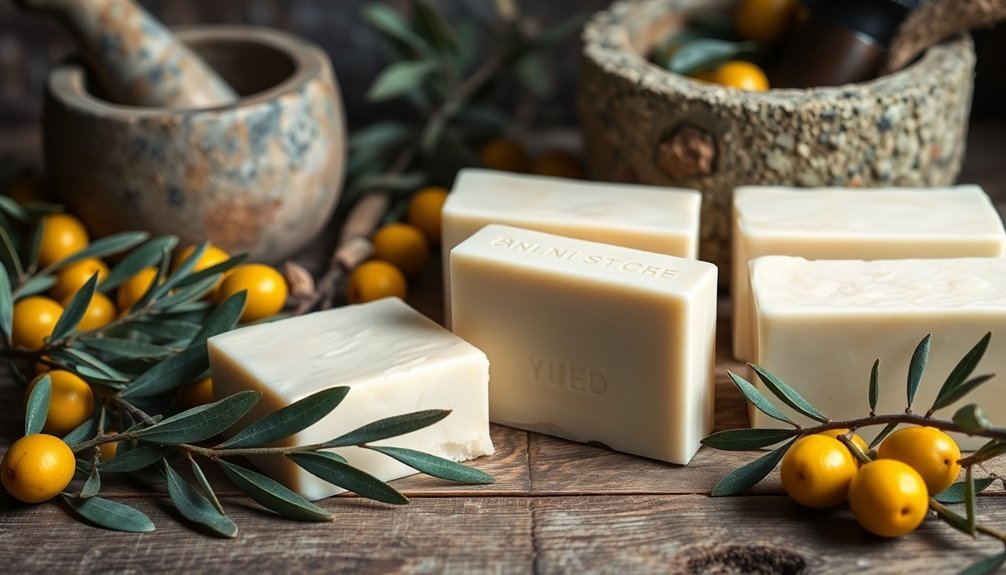
While many modern soaps boast complex formulations and synthetic ingredients, Castile soap traces its lineage to a simpler time.
Originally inspired by Levantine Aleppo soap, this pure olive oil cleanser found its true home in Spain during the medieval period.
Castile soap's ancient roots in Levantine traditions blossomed into perfection among Spain's olive groves during medieval times.
The Crusaders likely introduced these soap-making techniques to Europe, where Spain's abundant olive oil resources transformed the practice.
Cities throughout Castile became bustling soap production centers, exporting their high-quality product across the continent.
You'll find the earliest written records of Castile soap in London port books from 1567, though its reputation had already spread through royal circles.
Spanish nobility prized it for its gentleness and effectiveness, setting a trend that would eventually reach throughout Europe despite religious and economic controversies in Protestant England, where it was derogatorily referred to as Popish soap due to its association with Catholic Spain.
Olive Oil: The Sacred Ingredient of Authentic Castile
You'll discover that olive oil's selection as Castile soap's cornerstone wasn't accidental, but rather stemmed from Spain's abundant olive groves providing an ideal sustainable alternative to animal tallow.
The quality of olive oil you choose matters greatly, with extra virgin offering premium results while pomace provides a more economical option without sacrificing the soap's gentle properties. Extra virgin olive oil creates a distinctively warm yellow soap with exceptional mildness.
When crafting authentic Castile, remember that this sacred ingredient directly influences not only the soap's moisturizing capabilities but also its curing time and ultimate texture.
Sacred Oil Legacy
Since ancient times, olive oil has remained the cornerstone ingredient of authentic Castile soap, tracing its origins to the abundant olive groves of Spain's Castile region. This sacred ingredient was influenced by Syrian Aleppo soap makers but adapted to utilize locally available olive oil instead of laurel oil. True liquid Castile soap requires potassium hydroxide (KOH) rather than sodium hydroxide used in bar soaps.
| Historical Impact | Modern Benefits |
|---|---|
| Medieval "gold standard" | Gentle for sensitive skin |
| Replaced harsh tallow soaps | Environmentally friendly |
| Favored by European nobility | Biodegradable formula |
| Artisanal craft tradition | Versatile for multiple uses |
You'll find traditional recipes still emphasize olive oil's dominance, with some artisans using extra virgin olive oil for premium quality. When making your own Castile soap, remember that using less water speeds up the tracing process and reduces curing time, while olive pomace offers a cost-effective alternative.
Quality Grading Matters
The quality of olive oil directly determines the character and benefits of authentic Castile soap, with each grade offering distinct properties for soap makers.
Traditional recipes favor EVOO for its purity and cold-pressed extraction methods, though virgin olive oil serves as a quality alternative with slightly higher acidity.
While you'll find pure olive oil (Grade A) provides consistency in commercial production, many soap makers opt for lower grades like pomace due to cost considerations.
The saponification process ultimately transforms all grades similarly, diminishing nutritional differences between them.
Your color preferences matter too—higher grades produce lighter-colored soaps while pomace yields greener bars. The pomace olive oil contains approximately 5-8% oil content extracted from the remaining olive paste after initial pressing.
Though economically tempting to choose less expensive options, purists maintain that authentic Castile soap should contain the highest quality olive oil available, honoring its Spanish heritage.
The Moorish Influence on Spanish Soap Crafting Techniques
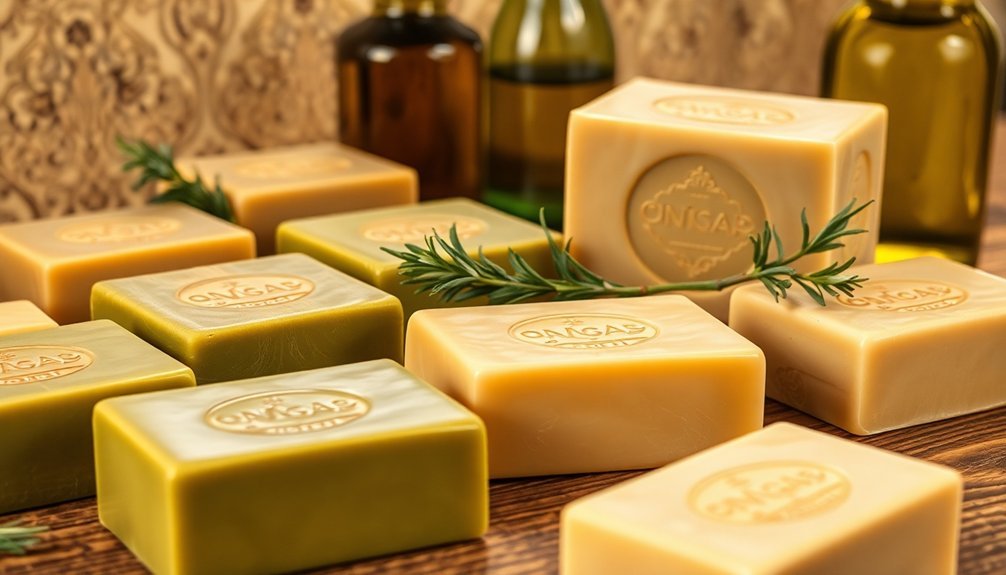
When the Moors invaded Spain in 711 AD, they brought with them more than just military might—they introduced revolutionary hygiene practices that would transform Spanish soap crafting for centuries to come. Ziryab's influence established bathing as essential to daily life, with specialized soap techniques replacing European cleansing methods. Personal care routines pioneered by Ziryab became integral to Spanish culture and soap production methods.
| Moorish Innovation | Impact on Spanish Soap |
|---|---|
| Olive oil formulations | Created milder, skin-friendly bases |
| Aromatic additions | Introduced perfumed varieties using local herbs |
| Scientific processing | Established precise chemical reactions for consistent quality |
| Irrigation systems | Enabled cultivation of soap-making ingredients |
You'll find these techniques still evident in authentic Castile soap today. The Moors' agricultural advancements—especially in olives and aromatics—provided essential ingredients while their scientific approach to production elevated soap from crude necessity to refined luxury.
Harvesting Traditional Ingredients From the Spanish Countryside
Nestled within Spain's sun-drenched countryside, traditional Castile soap ingredients have been harvested using methods passed down through generations.
You'll find olive harvesting at the heart of this process, typically occurring between October and December when farmers hand-pick the ripened fruit from ancient groves.
These olives are then pressed using stone or steel methods to extract the oil that forms Castile soap's backbone. Local wells and springs provide the water needed for saponification. Castile soap originated in the Castile region of Spain, known specifically for its high-quality olive oil.
The lifeblood of every Castile bar flows from ancient presses and pristine springs, a testament to Spanish simplicity.
When artisans add fragrance, they often use essential oils extracted through steam distillation from native plants like lavender and rosemary.
What makes this process remarkable is its sustainability. Olive trees require minimal water, the resulting soap is biodegradable, and production remains chemical-free and cruelty-free—preserving both Spanish traditions and the environment.
The Art of Lye Creation From Wood Ash in Historic Castile
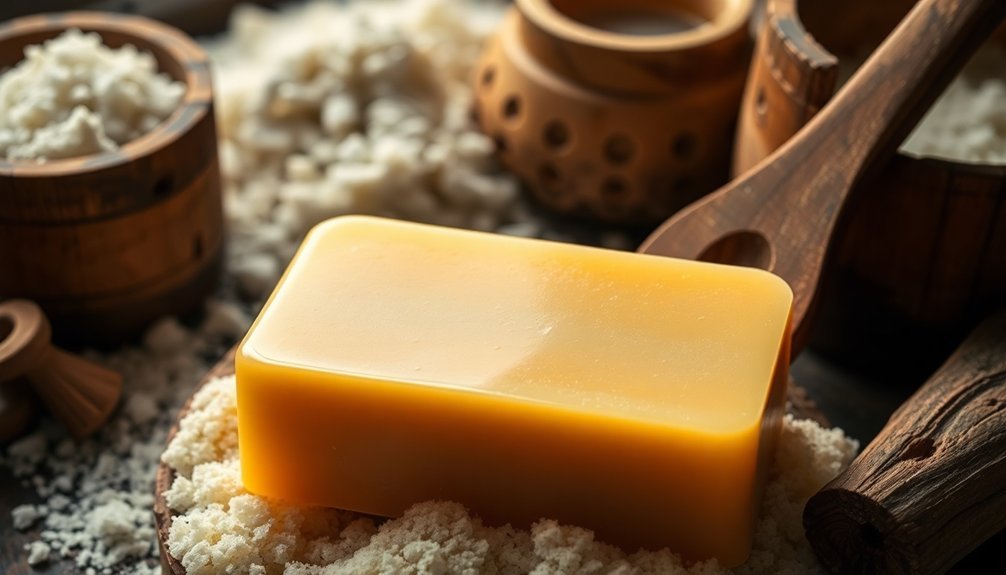
Ancient and remarkably effective, traditional lye production formed the backbone of historic Castile soap-making in Spain. Spanish artisans would carefully select oak and beech hardwoods, prized for their high potassium content.
After burning, they'd sift the white ash to remove unburnt chunks, ensuring a clearer lye solution.
The leaching barrel technique became the standard method in Castile, where you'd:
- Create a layered barrel with straw at the bottom and sifted ash above
- Pour soft water through the ash repeatedly until it reached proper strength
- Test the solution's potency using the floating egg method
- Neutralize accidental splashes with vinegar, not water
Winter harvests yielded the most ash, making soap-making a seasonal tradition that supported local economies while providing essential cleaning products. This process was accessible to all classes since lye is easy to make with simple materials found in any household.
Hand-Stirring Methods: Patience and Precision in the Trace
The traditional art of hand-stirring Castile soap requires immense patience and a well-trained eye to achieve the perfect trace. You'll need several essential tools: a digital thermometer, immersion blender, and silicone spatula to properly execute this technique.
Before beginning, make sure your lye solution and olive oil reach the ideal temperature of 100-110°F. Stir gently to prevent air bubbles, watching carefully for that magical moment when your mixture resembles thin pudding. This trace appears when the soap leaves a visible trail when drizzled onto itself.
While pure olive oil soaps take considerably longer to thicken than other varieties, you can expedite the process using an immersion blender. Adding sodium lactate can help produce firmer bars that are easier to unmold.
The patience required during this stage pays dividends – your diligence now directly impacts the quality of your finished Castile soap.
Wooden Molds and Drying Techniques of Spanish Artisans
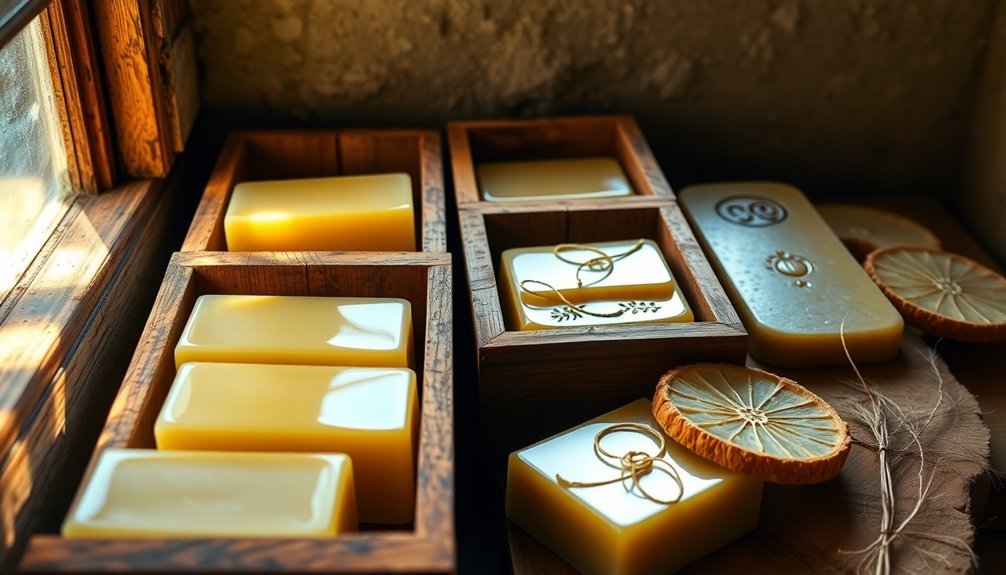
Traditional Spanish artisans craft their cedar soap molds with meticulous attention to detail, often incorporating regional designs that enhance the final product's aesthetic appeal.
You'll notice these wooden vessels frequently include silicone liners for easy unmolding, while preserving the artisanal character that mass-produced alternatives lack.
The soaps then cure on specialized drying frames in coastal regions, where the unique Mediterranean air circulation creates the perfect environment for developing Castile soap's characteristic texture and mildness. After cutting the hardened soap, artisans typically allow it to cure for one to two weeks before proceeding to the next steps of the production process.
Traditional Drying Frames
Spanish artisans have perfected wooden drying frames over centuries, creating a distinctive part of authentic Castile soap production.
After removing the hardened soap from molds, you'll find these specialized racks play an essential role in the curing process that develops the soap's legendary quality.
The traditional frames enable:
- Even air circulation around each bar, promoting uniform moisture evaporation
- Space optimization in drying areas, allowing batches to cure simultaneously
- Protection from direct sunlight that could alter the soap's natural pale yellow hue
- Proper hardening that enhances the soap's longevity and performance
You'll need patience during this vital phase—while usable after six weeks, true Castile soap reaches its peak lather quality and texture after several months to a year of careful curing. This extended curing period transforms the initially dense, somewhat slimy lather into the mild conditioning qualities that Castile soap is renowned for throughout Europe.
Cedar Soap Molds
Nestled within Spain's artisanal soap-making tradition, cedar soap molds represent centuries of refined craftsmanship and practical innovation.
You'll find these durable wooden vessels are prized for their natural moisture-wicking properties, which greatly enhance the soap drying process.
Spanish artisans favor cedar for its pleasant aroma and remarkable resistance to decay. The wood's natural grain prevents soap from sticking, making removal effortless.
Many traditional molds feature v-channel designs that minimize contact points while maximizing airflow. These authentic designs extend the life of soap bars by ensuring minimal contact with the moist surface.
Family-operated workshops throughout Spain craft these molds using locally-sourced Spanish cedar, often implementing techniques passed down through generations.
The resulting products balance functionality with rustic charm, allowing proper spacing between bars for even drying.
When you're working with authentic cedar molds, you're connecting with Spain's rich soap-making heritage.
Coastal Curing Methods
Along the rugged Spanish coastline, artisanal soap makers developed distinctive curing methods that capitalize on the region's unique maritime climate. The sea air's humidity required adjustments to traditional drying techniques, often lengthening the curing period to achieve the perfect bar hardness.
Coastal artisans adapted their craft through:
- Stacking soap bars with more space between them for improved air circulation
- Utilizing beechwood drying racks positioned to catch prevailing sea breezes
- Rotating bars more frequently to guarantee even moisture reduction
- Adjusting curing times seasonally to accommodate fluctuating coastal humidity levels
You'll find that these coastal techniques often resulted in slightly different textures than inland-produced Castile soaps. These extended curing times allowed for more complete water evaporation process, resulting in harder, longer-lasting bars.
These regional distinctions created unique variations that reflected both the environment and the craftsman's adaptation to maritime conditions.
The Nine-Month Curing Process of Traditional Castilian Soap
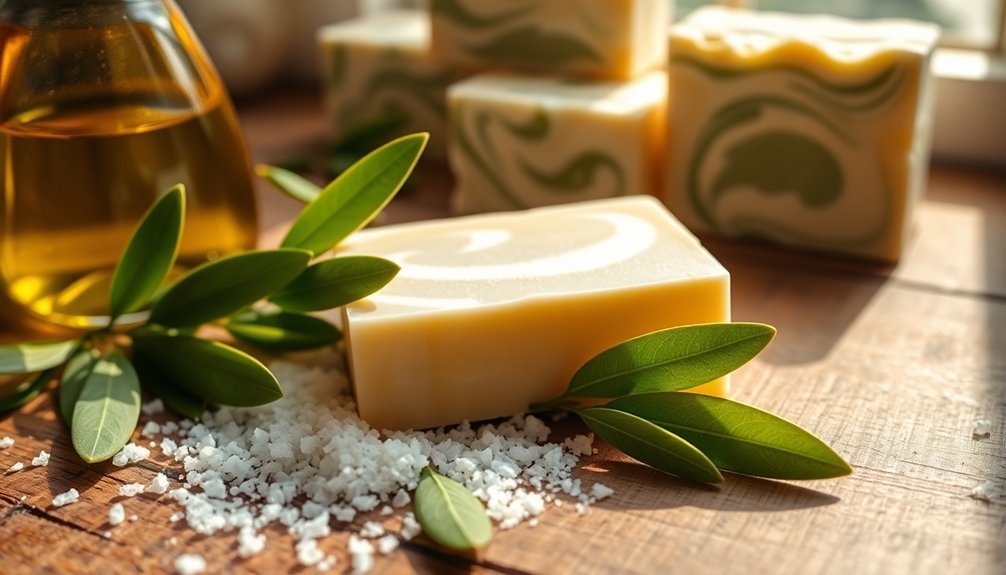
Traditional Castile soap reaches its full potential only through the time-honored nine-month curing process. This extended curing period transforms your soap from merely usable to exceptional. While you can use Castile after 4-6 weeks, you'll notice remarkable improvements in hardness, lather, and gentleness when you extend the curing time. Longer curing times of up to 12 months are actually recommended for olive oil soaps to achieve their optimal quality.
| Curing Stage | Observable Changes |
|---|---|
| 1-3 months | Hardening begins, water evaporates |
| 3-6 months | pH decreases, gentler on skin |
| 6-9 months | Lather quality improves considerably |
| 9+ months | Maximum hardness and longevity achieved |
During curing, maintain good air circulation by placing bars on racks with space between them. The patience required for proper curing yields a soap that's both longer-lasting and more luxurious to use.
Royal Patronage and the Rise of Castile Soap's Prestige
You'll find royal seals on many historical Castile soap packages, signifying the prestigious endorsement these products received from European monarchs.
Spanish royalty initially championed these soaps, with their preference quickly spreading to other courts where Castile soap became a fashionable luxury item. The transition from animal fat to high-quality olive oil established Castile soap as the gold standard throughout European noble circles for centuries.
The royal stamp of approval transformed this olive oil-based cleanser from a simple hygiene product into a coveted status symbol that elite households proudly displayed.
Royal Seals Influence
While many factors contributed to Castile soap's enduring legacy, royal patronage ultimately transformed this humble product into a prestigious commodity sought throughout Europe.
You'll find royal endorsements considerably elevated Castile soap's status beyond ordinary cleansers.
These prestigious connections created a powerful marketing advantage:
- Spanish royalty prized Castile soap for its pure white appearance and gentle olive oil composition
- Royal courts across Europe adopted the soap, establishing it as a luxury alternative to animal-fat varieties
- Strategic marketing often featured royal seals of approval, enhancing the soap's reputation
- Despite religious controversies in England during the 17th century, royal patronage maintained Castile soap's desirability
This royal influence helped establish Castile soap's cultural significance as both a personal hygiene product and fabric cleanser throughout medieval Europe. The soap's journey from the Silk Road to European households demonstrates its remarkable adaptability to different cultural contexts.
Court Fashion Trends
Court fashion trends elevated Castile soap from a mere cleansing agent to an essential status symbol within royal circles.
As aristocrats across Europe adopted this Spanish luxury, they enhanced its prestige by incorporating it into elaborate beauty rituals. You'd find ladies-in-waiting preparing scented versions with rose petals and herbs for royal bathing ceremonies.
The soap's gentle olive oil base made it particularly valuable for maintaining the pale, unblemished complexion that signified nobility. Unlike harsh tallow-based alternatives, Castile soap preserved delicate skin—a significant advantage when your social standing depended on appearance. Initially considered a luxury item exclusively for aristocratic elites, Castile soap eventually became accessible to the general population as production methods improved.
Royal patronage guaranteed its continued production and export throughout Europe, despite resistance in places like England where local soaps competed for favor. This royal endorsement transformed Castile soap into the cosmetic standard that influenced European hygiene practices for centuries.
From Luxury to Necessity: Castile Soap's Journey Through Spanish Society
The transformation of Castile soap from an exclusive luxury to a household necessity marks one of Spain's most fascinating cultural shifts during the medieval and Renaissance periods.
The humble Castile soap's journey from royal chambers to common homes mirrors Spain's evolving cultural identity across centuries.
You'd find this humble olive oil soap first among royalty, then gradually reaching commoners as production techniques improved.
This democratization happened through:
- Monastic communities producing high-quality soap while maintaining rigorous hygiene standards
- Versatile applications for skin, hair, clothing, and household cleaning
- Cultural significance as a symbol of purity in Spanish tradition
- Perfected production methods that made it more affordable
What began as an aristocratic indulgence eventually became a symbol of Spanish practical ingenuity.
The soap's journey reflects broader societal changes as hygiene practices spread from the privileged few to everyday households throughout the Iberian Peninsula. European soap-makers created Castile soap when they substituted olive oil for the laurel oil used in traditional Aleppo soap recipes.
Preserving Authentic Recipes: Grandmother's Wisdom Across Generations
Across centuries of Spanish households, authentic Castile soap recipes have been carefully preserved through the wisdom of grandmothers who understood its timeless value.
These matriarchs passed down the essential knowledge of combining pure olive oil with sodium hydroxide to create a soap unmatched in gentleness and durability.
You'll find that traditional methods emphasize hand-stirring with wooden tools until the mixture reaches a honey-like consistency.
While modern stick blenders offer convenience, the fundamental techniques remain unchanged.
The six-month curing period—critical for developing hardness and mildness—can't be rushed.
What makes these recipes authentic is their simplicity: genuine olive oil as the primary ingredient, with only natural fragrances or colorants added.
This purity reflects both regional adaptation and environmental sustainability that Spanish families have valued for generations.
Modern enthusiasts can experience this heritage through melt and pour bases that simplify the soap-making process while preserving the essential qualities of traditional Castile soap.
Recreating the Original Castile Formula in Modern Kitchens
Bringing these ancestral recipes into today's kitchens remains surprisingly straightforward, though modern tools have simplified the process.
You'll need olive oil as your primary ingredient, potassium hydroxide for saponification, distilled water, and optionally, glycerin to enhance moisturizing properties.
Your modern kitchen offers advantages your grandmother never had:
- Slow cookers maintain perfect temperature throughout the 3-4 hour cooking process
- Immersion blenders accelerate mixing and guarantee consistent texture
- Protective gear (gloves and goggles) increases safety when handling caustic KOH
- Custom additions like essential oils or coconut oil allow personalization
Remember to add KOH to water—never the reverse—and stir regularly as your mixture transforms into that creamy, versatile soap your ancestors would recognize and approve of.
As you blend the oils and lye solution, you'll notice the consistency changes from runny to a thick trace resembling Elmer's glue before it eventually becomes a translucent gel.
Frequently Asked Questions
Can Castile Soap Be Used for Treating Skin Conditions?
Yes, you can use castile soap to treat skin conditions like acne, eczema, and psoriasis. It's gentle, contains anti-inflammatory compounds like oleocanthal, and won't strip your skin's natural moisture while cleansing effectively.
How Does Water Hardness Affect Castile Soap's Performance?
Hard water dramatically reduces castile soap's performance as calcium and magnesium ions bind with soap molecules, creating scum. You'll notice less lather, reduced cleaning power, and may experience residue buildup in your hair.
Is Castile Soap Safe for Washing Fruits and Vegetables?
Yes, castile soap is safe for washing fruits and vegetables. You'll find it's non-toxic, biodegradable, and won't leave harmful residues. Just use a small amount in water, then rinse thoroughly before eating.
What Distinguishes Spanish Castile Soap From Other European Varieties?
Spanish Castile soap differs from other European varieties mainly through its pure olive oil base. You'll notice it's milder, more moisturizing, and follows traditional monastic production methods that date back to 11th century Spain.
Can Castile Soap Be Customized With Essential Oils?
Yes, you can customize Castile soap with essential oils. You'll need to add 1.5% oils by volume, possibly using heat blending or stabilizers like polysorbate 20 to prevent separation and maintain soap quality.
In Summary
You've now glimpsed the ancient art behind true Castile soap. By embracing these original Spanish methods, you're not just making soap—you're continuing a centuries-old tradition. Whether you're harvesting olive oil or measuring wood ash lye, you're connecting with medieval craftspeople who perfected this gentle cleanser. Don't hesitate to try these authentic techniques; your skin and heritage will thank you.

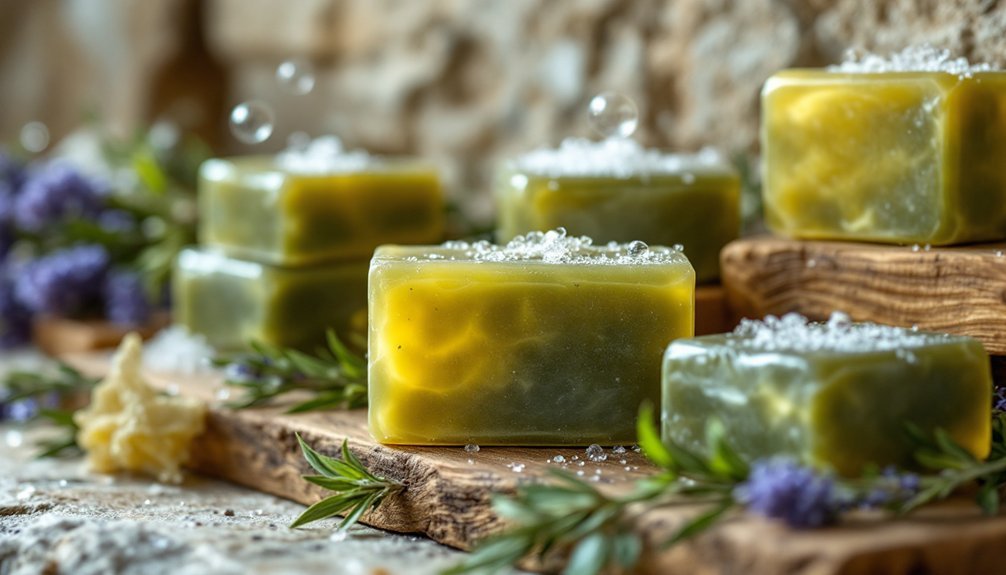



Leave a Reply